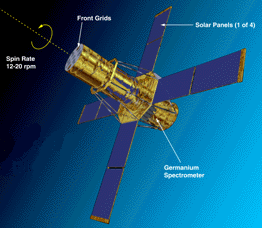UC
Berkeley/NASA launch HESSI satellite, continued:
UC
Berkeley's mission control
31
January 2002
Once
in orbit, the satellite comes under UC Berkeley's control, with commands
uplinked and data downlinked through a 36-foot (11 meters) radio dish
perched in the wooded hills above UC Berkeley. From mission control
in the nearby Space Sciences Laboratory, HESSI mission operators will
monitor the automatic pointing of the satellite toward the sun, deployment
of the four solar panels, and the spin-up of the satellite to about
15 revolutions per minute.
 |
| Artist's
concept of HESSI spacecraft in orbit, spinning around an axis pointing
at the sun. Hi-res
version. NASA picture |
Once
power is being supplied from the solar panels to onboard
batteries, the operators will start the onboard cooler to
get the germanium detectors down to 75 Kelvin (324 degrees
below zero Fahrenheit or 198 degrees below zero Celsius).
This will take several days, but is necessary before any
flare observations can be made. The nine germanium detectors
represent the largest and most advanced array of germanium
detectors ever flown in space.
Because
hard X-rays and gamma rays cannot be focused like visible
light — gamma rays can pass right through the spacecraft
— HESSI uses a novel technique to produce pictures
of flares. Pairs of grids, each etched from dense materials
that block gamma rays and hard X-rays, are aligned to let
radiation from only a small portion of the sun pass through
to the detector. As the satellite spins along an axis pointing
at the sun, nine of these grid pairs create a moving light
show on the germanium detectors.
The information
is sent back to Earth, where computers translate the data
into pictures of the flare every second or so. It is also
possible to obtain the energy spectrum of the hard X-rays
and gamma-rays at each location in the pictures.
Information
is stored on the spacecraft and sent to the ground whenever
the satellite passes over Berkeley, about every 90 minutes
for about a third of the day. The HESSI team has enlisted
the help of radio antennas in Europe and the eastern United
States to download data during very active periods when
several large flares may fill the onboard memory before
it can be emptied during the Berkeley passes. The team hopes
to detect upwards of a hundred gamma-ray flares, more than
a thousand X-ray flares, and perhaps 10,000 microflares
during the two- to three-year duration of the mission.
Lin and
his scientific team will compare the X-ray and gamma-ray
images from HESSI with pictures from other solar observing
satellites at different wavelengths to probe the mechanism
of flare formation. The data will be made freely available
online within hours of receipt at the ground station.
<<
previous
| continued >>
 |
| The
Berkeley Ground Station in the hills above the University
of California campus. UC Berkeley photo |
|